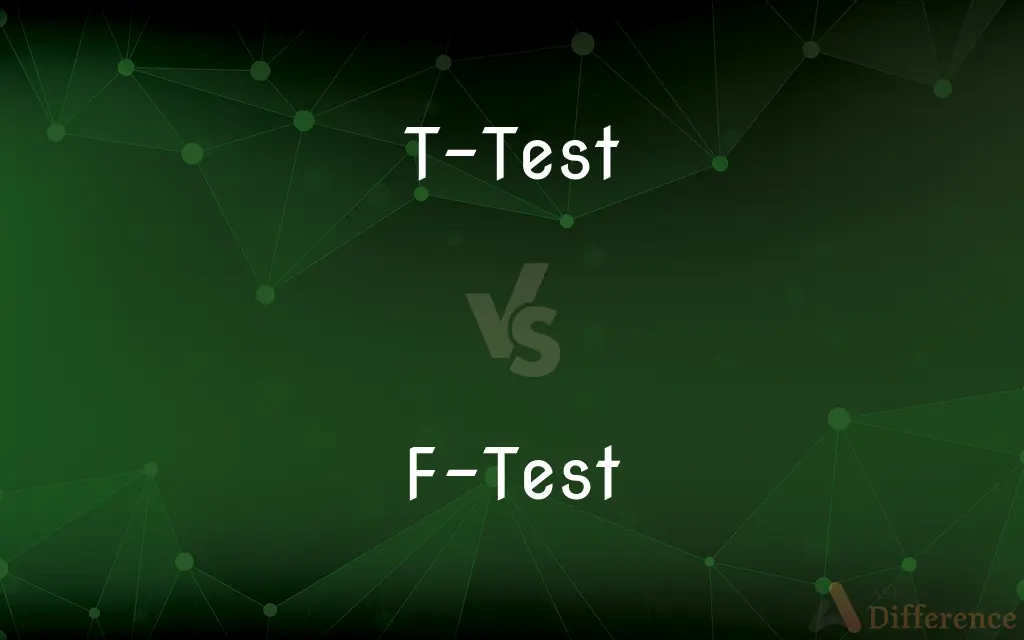T-Test vs. F-Test — What's the Difference?
By Tayyaba Rehman — Published on December 21, 2023
T-Test compares the means of two groups, while F-Test assesses variances between multiple groups' data sets.

Difference Between T-Test and F-Test
Table of Contents
ADVERTISEMENT
Key Differences
The T-Test and F-Test are statistical tests used to make inferences about populations based on sample data. The T-Test is specifically used to determine if there is a significant difference between the means of two independent groups. In essence, the T-Test helps researchers understand if two sets of data are significantly different from one another based on their means.
The F-Test, in contrast, is used to compare the variances of two or more groups. It's primarily employed in the context of analysis of variance (ANOVA) or regression analysis. The F-Test examines whether the variances between multiple groups are equal, making it suitable for scenarios where one needs to analyze the variability among more than two data sets.
Whereas the T-Test's core focus is on mean comparison, the F-Test emphasizes variance comparison. The T-Test often operates under the assumption that variances are equal, while the F-Test, especially in ANOVA, helps in determining if the means across multiple groups are the same by first looking at variances.
Another distinct difference is in their application. A T-Test might be used in pharmaceutical research to see if a drug has different effects on two separate groups, while an F-Test might be applied in agriculture to determine if different fertilizers produce varying amounts of crop yield variance. Both the T-Test and F-Test serve crucial roles in statistics, offering different insights depending on the research question at hand.
Comparison Chart
Primary Purpose
Compare means
Compare variances
ADVERTISEMENT
Number of Groups
Two
Two or more
Assumptions
Often assumes equal variances
Compares variances
Application Scenarios
Two-group comparisons (e.g., drug vs. placebo)
Multiple group variability (e.g., different fertilizers)
Test Statistic
T-statistic
F-statistic
Compare with Definitions
T-Test
Measures the probability of differences occurring by chance.
A low p-value from the T-Test indicates a meaningful difference.
F-Test
Compares variances of two or more data sets.
The F-Test demonstrated unequal variance between the four plant growth conditions.
T-Test
Assesses if two sets of data are significantly different.
Using a T-Test, the scientist disproved the initial hypothesis.
F-Test
Evaluates hypothesis on variances.
Using the F-Test, the researcher confirmed homogeneity of variances.
T-Test
Compares means of two independent samples.
A paired T-Test was used to compare pre and post-treatment scores.
F-Test
Measures ratio of two variances.
A high F-statistic from the F-Test suggested significant group differences.
T-Test
A statistical test comparing two group means.
The T-Test revealed a significant difference between the control and experimental groups.
F-Test
Tests if multiple groups have the same population variance.
The F-Test in the regression analysis indicated that the model was fit.
T-Test
A tool for testing the null hypothesis regarding group means.
The T-Test results rejected the null hypothesis.
F-Test
Used in ANOVA to test equality of means.
Through the F-Test, it was evident that at least one treatment was effective.
T-Test
(statistics) Student's t-test
Common Curiosities
Is equal variance a requirement for a T-Test?
Many T-Tests assume equal variances, but there are variations that don't.
What's the main purpose of a T-Test?
The T-Test is used to compare the means of two groups.
In what scenarios is the T-Test most applicable?
The T-Test is ideal for comparing means of two independent or paired groups.
Can the F-Test be used for two groups?
Yes, it can compare variances of two or more groups.
Can the T-Test be used for more than two groups?
No, for more than two groups, an ANOVA with the F-Test is appropriate.
Which test has a t-statistic?
The T-Test yields a t-statistic.
How does the F-Test evaluate variances?
The F-Test compares the variances of two or more data sets.
What's the key statistic of an F-Test?
The key statistic is the F-statistic.
How does the F-Test relate to ANOVA?
The F-Test is the primary test used in ANOVA to compare means.
Can the T-Test handle paired data?
Yes, there's a specific variant known as the paired T-Test for this.
What happens when the T-Test's assumptions aren't met?
Alternative tests or variations, like the Welch's T-Test, can be used.
Is the F-Test only for variance comparison?
Primarily, yes, but it's also central to regression and ANOVA analyses.
How do I choose between a T-Test and F-Test?
It depends on the research question; means comparison for two groups requires a T-Test, while variance comparison or multiple group mean comparisons use an F-Test.
What's the output of an F-Test in ANOVA?
The F-Test provides an F-statistic and associated p-value in ANOVA.
Is the F-Test applicable to linear regression?
Yes, it's used to test the overall significance of a model.
Share Your Discovery

Previous Comparison
Xbox Live Silver vs. Xbox Live Gold
Next Comparison
Grizzly Bear vs. GorillaAuthor Spotlight
Written by
Tayyaba RehmanTayyaba Rehman is a distinguished writer, currently serving as a primary contributor to askdifference.com. As a researcher in semantics and etymology, Tayyaba's passion for the complexity of languages and their distinctions has found a perfect home on the platform. Tayyaba delves into the intricacies of language, distinguishing between commonly confused words and phrases, thereby providing clarity for readers worldwide.
















































